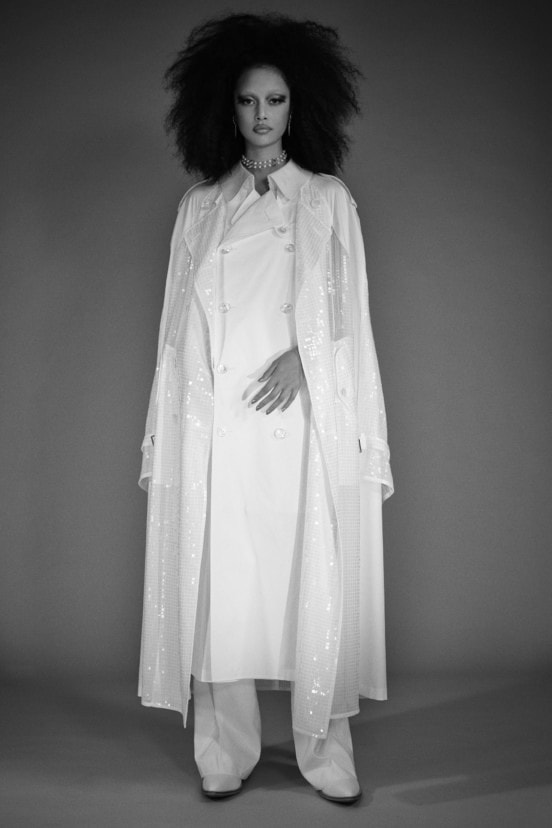Review of Junya Watanabe Spring 2021 Fashion Show
Function & Practicality Redux
By Long Nguyen
“It is a collection that reproduces the costumes worn by the stars in my memories. My memories are monochrome, and I created a photo session with four fictional stars,” said Junya Watanabe of the release of his black and white silent film in slow motion in conjunction with an installation on mannequins of the clothes of spring collection at the Tokyo headquarter.
Watanabe’s spring collection featured clothes mostly exclusive in sparkling black and plain white with a couple of silver dresses in a collection that was less about introspection and reminiscence than about simply creating a different assortments of garments done with the usual appetites for the design rigors and here now perhaps with a continued sense of the designer’s encyclopedic approach to fashion.

A white sequined oversized cape-sweatshirt dress over a white tank and white sequin legging pant, a black tulle sequined asymmetrical long sleeve over the head flare ‘sweater’ with matching legging, a black and a white sparkling bubble hemmed short dress, a black sequined oversized long dress, or a sparking black trench over a black long shirt dress felt like an unusual collection clothes for Watanabe whose recent shows had focused on magnifying the subcultural influences like the Fall 2020 show that revolved around the fashion era of Debbie Harry or the high octane collection Watanabe in the punk collection he showed for Fall 2017.
These spring clothes have an inkling of more the staples of mundane clothes Watanabe is known for particularly in his work on menswear than of high fashion.
Watanabe is a designer who is always more than obsessed with details.
Since his debut in Paris in 1993 and the year before in Tokyo, he could do an entire show and collection with just working on the variations of a single idea, exploring every permutations possible within that one concept or that one specific garment or fabric – denim (Spring 2002), trench coat (Spring 2020), leather biker (Fall 2007), working class clothes (Spring 2006).
Here with this spring collection, Watanabe basically worked with this one shape in the strongest part of the collection with clean lines – an over the head oversize tunic-sweatshirt – and masterfully transformed one shape into a variety of garments of different proportions with classic cuts that morphed from a short dress into a large cape and also into a simple black halter dress. The clothes may look comfortable as they wrapped around the body effortlessly connecting the body to the clothes but they don’t convey homeliness; the clothes may look at first glance a bit precious but they don’t belong in high luxury; and the clothes may feel simple but they are complex in their designs, cuts and drapes.

This collection is a movement forward rather than one of forwarding nostalgia as Watanabe relied on his own fashion intuition rather than in borrowing style elements from different eras and cultures albeit infusing whatever ideas taken and adopted with his own unique interpretations in clothes.

It isn’t a collection that the Junya Watanabe’s audience is inherently familiar with as he kept the cuts and the fabrics to a minimal without any real historical or cultural relics to rely on. These clothes somehow reminded me of some of Watanabe’s shows in the late 1990’s especially the Spring 1998 show at the Beaux Arts and perhaps in its own way the break through Spring 2000 show titled Function and Practicality where in one moment models stopped, undressed and inverted their garments and in another models carried umbrellas as simulated rain dropped on the garments to prove their water resistance properties. Now, function and practicality regain a second life but one very difference from their first iteration.
